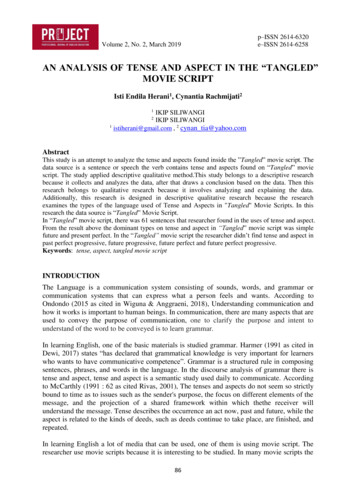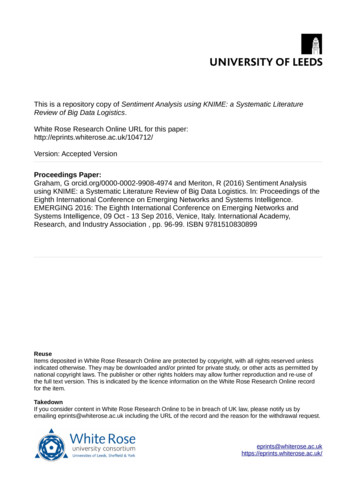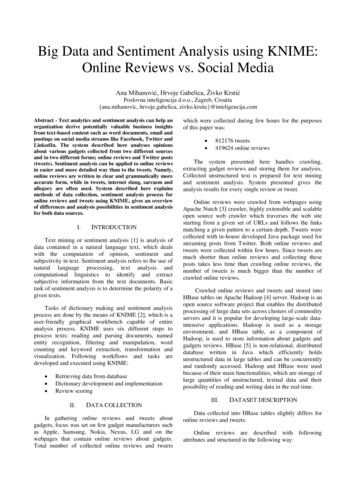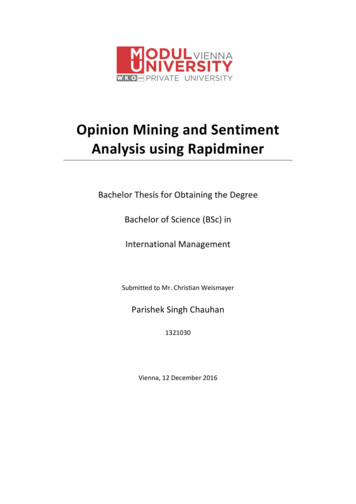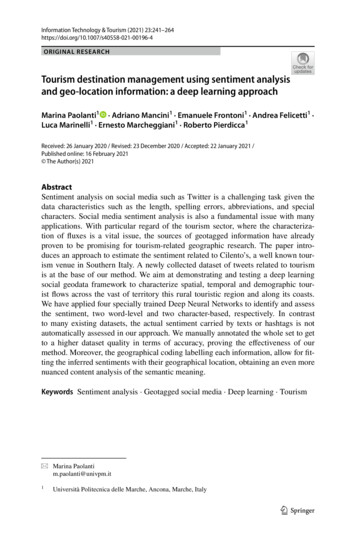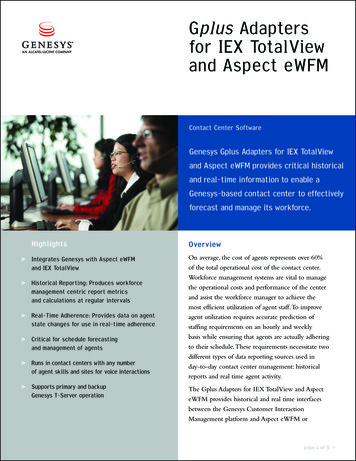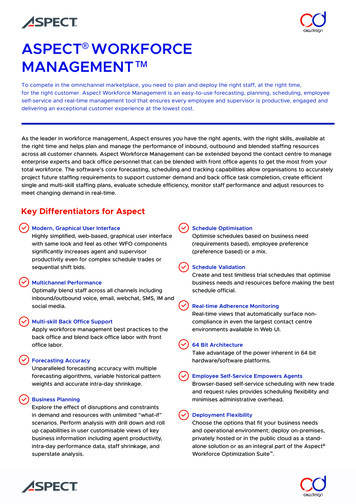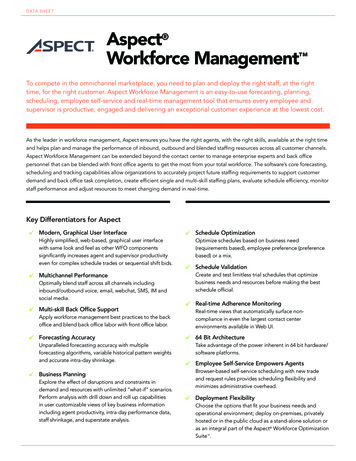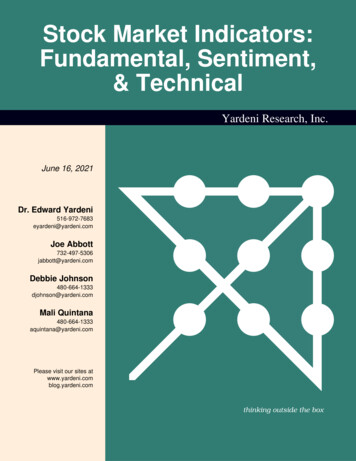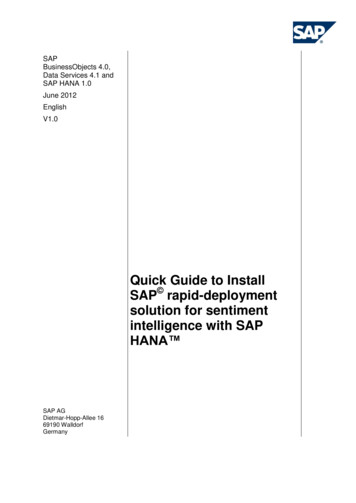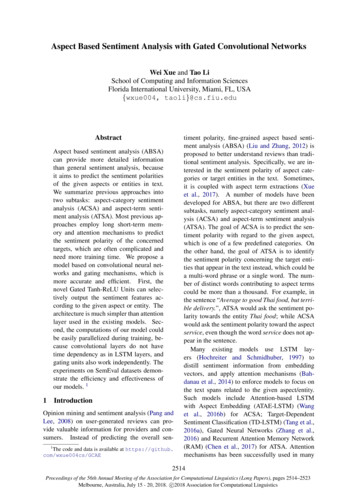
Transcription
Aspect Based Sentiment Analysis with Gated Convolutional NetworksWei Xue and Tao LiSchool of Computing and Information SciencesFlorida International University, Miami, FL, USA{wxue004, taoli}@cs.fiu.eduAbstractAspect based sentiment analysis (ABSA)can provide more detailed informationthan general sentiment analysis, becauseit aims to predict the sentiment polaritiesof the given aspects or entities in text.We summarize previous approaches intotwo subtasks: aspect-category sentimentanalysis (ACSA) and aspect-term sentiment analysis (ATSA). Most previous approaches employ long short-term memory and attention mechanisms to predictthe sentiment polarity of the concernedtargets, which are often complicated andneed more training time. We propose amodel based on convolutional neural networks and gating mechanisms, which ismore accurate and efficient. First, thenovel Gated Tanh-ReLU Units can selectively output the sentiment features according to the given aspect or entity. Thearchitecture is much simpler than attentionlayer used in the existing models. Second, the computations of our model couldbe easily parallelized during training, because convolutional layers do not havetime dependency as in LSTM layers, andgating units also work independently. Theexperiments on SemEval datasets demonstrate the efficiency and effectiveness ofour models. 11IntroductionOpinion mining and sentiment analysis (Pang andLee, 2008) on user-generated reviews can provide valuable information for providers and consumers. Instead of predicting the overall sen1The code and data is available at https://github.com/wxue004cs/GCAEtiment polarity, fine-grained aspect based sentiment analysis (ABSA) (Liu and Zhang, 2012) isproposed to better understand reviews than traditional sentiment analysis. Specifically, we are interested in the sentiment polarity of aspect categories or target entities in the text. Sometimes,it is coupled with aspect term extractions (Xueet al., 2017). A number of models have beendeveloped for ABSA, but there are two differentsubtasks, namely aspect-category sentiment analysis (ACSA) and aspect-term sentiment analysis(ATSA). The goal of ACSA is to predict the sentiment polarity with regard to the given aspect,which is one of a few predefined categories. Onthe other hand, the goal of ATSA is to identifythe sentiment polarity concerning the target entities that appear in the text instead, which could bea multi-word phrase or a single word. The number of distinct words contributing to aspect termscould be more than a thousand. For example, inthe sentence “Average to good Thai food, but terrible delivery.”, ATSA would ask the sentiment polarity towards the entity Thai food; while ACSAwould ask the sentiment polarity toward the aspectservice, even though the word service does not appear in the sentence.Many existing models use LSTM layers (Hochreiter and Schmidhuber, 1997) todistill sentiment information from embeddingvectors, and apply attention mechanisms (Bahdanau et al., 2014) to enforce models to focus onthe text spans related to the given aspect/entity.Such models include Attention-based LSTMwith Aspect Embedding (ATAE-LSTM) (Wanget al., 2016b) for ACSA; Target-DependentSentiment Classification (TD-LSTM) (Tang et al.,2016a), Gated Neural Networks (Zhang et al.,2016) and Recurrent Attention Memory Network(RAM) (Chen et al., 2017) for ATSA. Attentionmechanisms has been successfully used in many2514Proceedings of the 56th Annual Meeting of the Association for Computational Linguistics (Long Papers), pages 2514–2523Melbourne, Australia, July 15 - 20, 2018. c 2018 Association for Computational Linguistics
NLP tasks. It first computes the alignment scoresbetween context vectors and target vector; thencarry out a weighted sum with the scores and thecontext vectors. However, the context vectorshave to encode both the aspect and sentimentinformation, and the alignment scores are appliedacross all feature dimensions regardless of the differences between these two types of information.Both LSTM and attention layer are very timeconsuming during training. LSTM processes onetoken in a step. Attention layer involves exponential operation and normalization of all alignmentscores of all the words in the sentence (Wanget al., 2016b). Moreover, some models needs thepositional information between words and targetsto produce weighted LSTM (Chen et al., 2017),which can be unreliable in noisy review text.Certainly, it is possible to achieve higher accuracyby building more and more complicated LSTMcells and sophisticated attention mechanisms; butone has to hold more parameters in memory, getmore hyper-parameters to tune and spend moretime in training. In this paper, we propose a fastand effective neural network for ACSA and ATSAbased on convolutions and gating mechanisms,which has much less training time than LSTMbased networks, but with better accuracy.For ACSA task, our model has two separateconvolutional layers on the top of the embeddinglayer, whose outputs are combined by novel gating units. Convolutional layers with multiple filters can efficiently extract n-gram features at manygranularities on each receptive field. The proposed gating units have two nonlinear gates, eachof which is connected to one convolutional layer.With the given aspect information, they can selectively extract aspect-specific sentiment information for sentiment prediction. For example, in thesentence “Average to good Thai food, but terribledelivery.”, when the aspect food is provided, thegating units automatically ignore the negative sentiment of aspect delivery from the second clause,and only output the positive sentiment from thefirst clause. Since each component of the proposedmodel could be easily parallelized, it has muchless training time than the models based on LSTMand attention mechanisms. For ATSA task, wherethe aspect terms consist of multiple words, we extend our model to include another convolutionallayer for the target expressions. We evaluate ourmodels on the SemEval datasets, which containsrestaurants and laptops reviews with labels on aspect level. To the best of our knowledge, no CNNbased model has been proposed for aspect basedsentiment analysis so far.2Related WorkWe present the relevant studies into following twocategories.2.1Neural NetworksRecently, neural networks have gained much popularity on sentiment analysis or sentence classification task. Tree-based recursive neural networkssuch as Recursive Neural Tensor Network (Socheret al., 2013) and Tree-LSTM (Tai et al., 2015),make use of syntactic interpretation of the sentence structure, but these methods suffer fromtime inefficiency and parsing errors on reviewtext. Recurrent Neural Networks (RNNs) such asLSTM (Hochreiter and Schmidhuber, 1997) andGRU (Chung et al., 2014) have been used for sentiment analysis on data instances having variablelength (Tang et al., 2015; Xu et al., 2016; Laiet al., 2015). There are also many models that useconvolutional neural networks (CNNs) (Collobertet al., 2011; Kalchbrenner et al., 2014; Kim, 2014;Conneau et al., 2016) in NLP, which also provethat convolution operations can capture compositional structure of texts with rich semantic information without laborious feature engineering.2.2Aspect based Sentiment AnalysisThere is abundant research work on aspect basedsentiment analysis. Actually, the name ABSA isused to describe two different subtasks in the literature. We classify the existing work into twomain categories based on the descriptions of sentiment analysis tasks in SemEval 2014 Task 4 (Pontiki et al., 2014): Aspect-Term Sentiment Analysisand Aspect-Category Sentiment Analysis.Aspect-Term Sentiment Analysis. In the firstcategory, sentiment analysis is performed towardthe aspect terms that are labeled in the given sentence. A large body of literature tries to utilize therelation or position between the target words andthe surrounding context words either by using thetree structure of dependency or by simply countingthe number of words between them as a relevanceinformation (Chen et al., 2017).Recursive neural networks (Lakkaraju et al.,2014; Dong et al., 2014; Wang et al., 2016a) rely2515
on external syntactic parsers, which can be veryinaccurate and slow on noisy texts like tweets andreviews, which may result in inferior performance.Recurrent neural networks are commonly usedin many NLP tasks as well as in ABSA problem. TD-LSTM (Tang et al., 2016a) and gatedneural networks (Zhang et al., 2016) use two orthree LSTM networks to model the left and rightcontexts of the given target individually. A fullyconnected layer with gating units predicts the sentiment polarity with the outputs of LSTM layers.Memory network (Weston et al., 2014) coupledwith multiple-hop attention attempts to explicitlyfocus only on the most informative context areato infer the sentiment polarity towards the target word (Tang et al., 2016b; Chen et al., 2017).Nonetheless, memory network simply bases itsknowledge bank on the embedding vectors of individual words (Tang et al., 2016b), which makesitself hard to learn the opinion word enclosedin more complicated contexts. The performanceis improved by using LSTM, attention layer andfeature engineering with word distance betweensurrounding words and target words to producetarget-specific memory (Chen et al., 2017).Aspect-Category Sentiment Analysis. In thiscategory, the model is asked to predict the sentiment polarity toward a predefined aspect category. Attention-based LSTM with Aspect Embedding (Wang et al., 2016b) uses the embedding vectors of aspect words to selectively attend the regions of the representations generated by LSTMs.3Gated Convolutional Network withAspect EmbeddingIn this section, we present a new model for ACSAand ATSA, namely Gated Convolutional networkwith Aspect Embedding (GCAE), which is moreefficient and simpler than recurrent network basedmodels (Wang et al., 2016b; Tang et al., 2016a;Ma et al., 2017; Chen et al., 2017). Recurrent neural networks sequentially compose hidden vectorshi f (hi 1 ), which does not enable parallelization over inputs. In the attention layer, softmaxnormalization also has to wait for all the alignmentscores computed by a similarity function. Hence,they cannot take advantage of highly-parallelizedmodern hardware and libraries. Our model is builton convolutional layers and gating units. Eachconvolutional filter computes n-gram features atdifferent granularities from the embedding vectorsat each position individually. The gating units ontop of the convolutional layers at each positionare also independent from each other. Therefore,our model is more suitable to parallel computing.Moreover, our model is equipped with two kindsof effective filtering mechanisms: the gating unitson top of the convolutional layers and the maxpooling layer, both of which can accurately generate and select aspect-related sentiment features.We first briefly review the vanilla CNN for textclassification (Kim, 2014). The model achievesstate-of-the-art performance on many standardsentiment classification datasets (Le et al., 2017).The CNN model consists of an embeddinglayer, a one-dimension convolutional layer and amax-pooling layer. The embedding layer takes theindices wi {1, 2, . . . , V } of the input wordsand outputs the corresponding embedding vectors v i RD . D denotes the dimension sizeof the embedding vectors. V is the size of theword vocabulary. The embedding layer is usually initialized with pre-trained embeddings suchas GloVe (Pennington et al., 2014), then they arefine-tuned during the training stage. The onedimension convolutional layer convolves the inputs with multiple convolutional kernels of different widths. Each kernel corresponds a linguisticfeature detector which extracts a specific patternof n-gram at various granularities (Kalchbrenneret al., 2014). Specifically, the input sentence isrepresented by a matrix through the embeddinglayer, X [v 1 , v 2 , . . . , v L ], where L is the lengthof the sentence with padding. A convolutional filter Wc RD k maps k words in the receptivefield to a single feature c. As we slide the filteracross the whole sentence, we obtain a sequenceof new features c [c1 , c2 , . . . , cL ].ci f (Xi:i K Wc bc ),(1)where bc R is the bias, f is a non-linear activation function such as tanh function, denotesconvolution operation. If there are nk filters ofthe same width k, the output features form a matrix C Rnk Lk . For each convolutional filter,the max-over-time pooling layer takes the maximal value among the generated convolutional features, resulting in a fixed-size vector whose size isequal to the number of filters nk . Finally, a softmax layer uses the vector to predict the sentimentpolarity of the input sentence.Figure 1 illustrates our model architecture. The2516
Sentimentsoftmaxwhere i is the index of a data sample, j is the indexof a sentiment class.Max g···Convolutions···sushiarerollsgreatWord EmbeddingsFigure 1: Illustration of our model GCAE forACSA task. A pair of convolutional neuron computes features for a pair of gates: tanh gate andReLU gate. The ReLU gate receives the givenaspect information to control the propagation ofsentiment features. The outputs of two gates areelement-wisely multiplied for the max poolinglayer.Gated Tanh-ReLU Units (GTRU) with aspect embedding are connected to two convolutional neurons at each position t. Specifically, we computethe features ci asai relu(Xi:i k Wa Va v a ba )(2)ci si ai(4)si tanh(Xi:i k Ws bs ),(3)where v a is the embedding vector of the given aspect category in ACSA or computed by anotherCNN over aspect terms in ATSA. The two convolutions in Equation 2 and 3 are the same as theconvolution in the vanilla CNN, but the convolutional features ai receives additional aspect information v a with ReLU activation function. Inother words, si and ai are responsible for generating sentiment features and aspect features respectively. The above max-over-time pooling layergenerates a fixed-size vector e Rdk , whichkeeps the most salient sentiment features of thewhole sentence. The final fully-connected layerwith softmax function uses the vector e to predict the sentiment polarity ŷ. The model is trainedby minimizing the cross-entropy loss between theground-truth y and the predicted value ŷ for alldata samples.XX jL yi log ŷij ,(5)ijGating MechanismsThe proposed Gated Tanh-ReLU Units controlthe path through which the sentiment informationflows towards the pooling layer. The gating mechanisms have proven to be effective in LSTM. In aspect based sentiment analysis, it is very commonthat different aspects with different sentiments appear in one sentence. The ReLU gate in Equation 2does not have upper bound on positive inputs butstrictly zero on negative inputs. Therefore, it canoutput a similarity score according to the relevancebetween the given aspect information v a and theaspect feature ai at position t. If this score is zero,the sentiment features si would be blocked at thegate; otherwise, its magnitude would be amplifiedaccordingly. The max-over-time pooling furtherremoves the sentiment features which are not significant over the whole sentence.In language modeling (Dauphin et al., 2017;Kalchbrenner et al., 2016; van den Oord et al.,2016; Gehring et al., 2017), Gated Tanh Units(GTU) and Gated Linear Units (GLU) have showneffectiveness of gating mechanisms. GTU is represented by tanh(X W b) σ(X V c), inwhich the sigmoid gates control features for predicting the next word in a stacked convolutionalblock. To overcome the gradient vanishing problem of GTU, GLU uses (X W b) σ(X V c)instead, so that the gradients would not be downscaled to propagate through many stacked convolutional layers. However, a neural network thathas only one convolutional layer would not suffer from gradient vanish problem during training.We show that on text classification problem, ourGTRU is more effective than these two gatingunits.5GCAE on ATSAATSA task is defined to predict the sentiment polarity of the aspect terms in the given sentence.We simply extend GCAE by adding a small convolutional layer on aspect terms, as shown in Figure 2. In ACSA, the aspect information controllingthe flow of sentiment features in GTRU is fromone aspect word; while in ATSA, such information is provided by a small CNN on aspect terms[wi , wi 1 , . . . , wi k ]. The additional CNN extracts the important features from multiple words2517
SentimentsoftmaxMax Pooling···GTRU···Max great PAD Context Embeddingssushirolls PAD Target EmbeddingsFigure 2: Illustration of model GCAE for ATSA task. It has an additional convolutional layer on aspectterms.while retains the ability of parallel computing.66.1ExperimentsDatasets and Experiment PreparationWe conduct experiments on public datasets fromSemEval workshops (Pontiki et al., 2014), whichconsist of customer reviews about restaurants andlaptops. Some existing work (Wang et al., 2016b;Ma et al., 2017; Chen et al., 2017) removed “conflict” labels from four sentiment labels, whichmakes their results incomparable to those from theworkshop report (Kiritchenko et al., 2014). Wereimplemented the compared methods, and usedhyper-parameter settings described in these references.The sentences which have different sentimentlabels for different aspects or targets in the sentence are more common in review data than instandard sentiment classification benchmark. Thesentence in Table 1 shows the reviewer’s differentattitude towards two aspects: food and delivery.Therefore, to access how the models perform onreview sentences more accurately, we create smallbut difficult datasets, which are made up of thesentences having opposite or different sentimentson different aspects/targets. In Table 1, the twoidentical sentences but with different sentiment labels are both included in the dataset. If a sentencehas 4 aspect targets, this sentence would have 4copies in the data set, each of which is associatedwith different target and sentiment label.For ACSA task, we conduct experiments onrestaurant review data of SemEval 2014 Task 4.There are 5 aspects: food, price, service, ambience, and misc; 4 sentiment polarities: positive,negative, neutral, and conflict. By merging restaurant reviews of three years 2014 - 2016, we obtaina larger dataset called “Restaurant-Large”. Incompatibilities of data are fixed during merging. Wereplace conflict labels with neutral labels in the2014 dataset. In the 2015 and 2016 datasets, therecould be multiple pairs of “aspect terms” and “aspect category” in one sentence. For each sentence,let p denote the number of positive labels minusthe number of negative labels. We assign a sentence a positive label if p 0, a negative label ifp 0, or a neutral label if p 0. After removingduplicates, the statistics are show in Table 2. Theresulting dataset has 8 aspects: restaurant, food,drinks, ambience, service, price, misc and location.For ATSA task, we use restaurant reviews andlaptop reviews from SemEval 2014 Task 4. Oneach dataset, we duplicate each sentence na times,which is equal to the number of associated aspectcategories (ACSA) or aspect terms (ATSA) (Ruderet al., 2016b,a). The statistics of the datasets areshown in Table 2.The sizes of hard data sets are also shown in Table 2. The test set is designed to measure whethera model can detect multiple different sentimentpolarities in one sentence toward different entities. Without such sentences, a classifier for overall sentiment classification might be good enough2518
SentenceAverage to good Thai food, but terrible delivery.Average to good Thai food, but terrible delivery.aspect category/termfooddeliverysentiment labelpositivenegativeTable 1: Two example sentences in one hard test set of restaurant review dataset of SemEval 2014.for the se
Opinion mining and sentiment analysis (Pang and Lee,2008) on user-generated reviews can pro-vide valuable information for providers and con-sumers. Instead of predicting the overall sen-1The code and data is available at https://github. com/wxue004cs/GCAE timent polarity, fine-grained aspect
